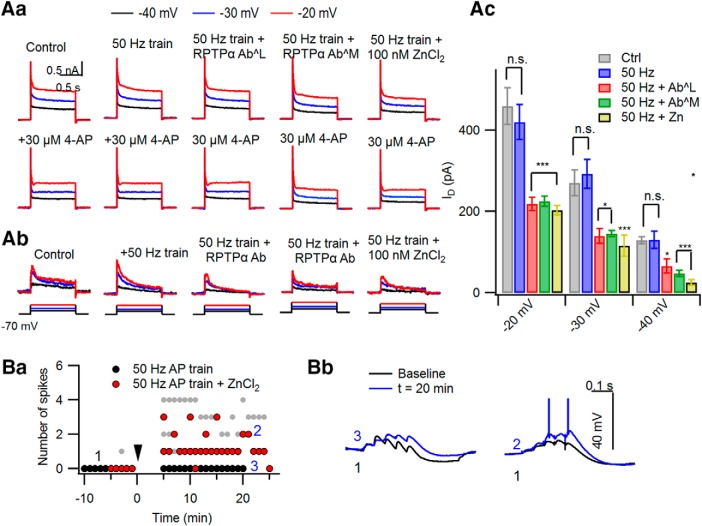Figure 7.
Supplement of Zn2+ to aCSF allows 50 Hz somatic stimulation to induce reduction of D-type K current and E-S potentiation of PP inputs. Aa, Ab, Outward K+ IK elicited by a depolarizing step to −20 mV (red), −30 mV (blue), and −40 mV (black) from −70 mV before (Aa, top row) and after bath application of 30 μm 4-AP (Aa, bottom row) in the naive and conditioned CA3-PCs. For each condition, the arithmetical subtraction of IK under the 4-AP (bottom row) from the total IK (top row) at the same depolarizing step was regarded as IKD. Representative traces for IKD are shown in Ab. Ac, Mean values for peak amplitudes of IKD induced by a step depolarization to −20, −30, and −40 mV under different conditions. Ctrl, Without conditioning; 50 Hz, after 50 Hz somatic AP trains; 50 Hz + AbL and 50 Hz + AbM, intracellular perfusion of anti-RPTPα AbL and anti-RPTPα AbM, respectively; 50 Hz + Zn, 100 nm Zn2+ supplemented to aCSF. Ba, Number of APs elicited by five PP-EPSP trains at 20 Hz before and after 50 Hz somatic AP trains (arrowhead at 0 min). The 50 Hz AP train alone did not enhance the number of APs induced by PP synaptic inputs (black symbols). With 100 nm ZnCl2 supplemented to aCSF, however, the 50 Hz AP train enhanced the number of APs (red symbols. For comparison, AP numbers elicited by PP-EPSP bursts at 20 Hz after a 10 Hz somatic AP train are reproduced from Hyun et al. (2015) (gray symbols). Bb, Exemplar traces for temporal summation of 20 Hz PP-EPSPs before (black) and after (blue) the 50 Hz AP train without (left) and with (right) ZnCl2 supplement. n.s., No statistical significance. *p < 0.05; ***p < 0.005.

